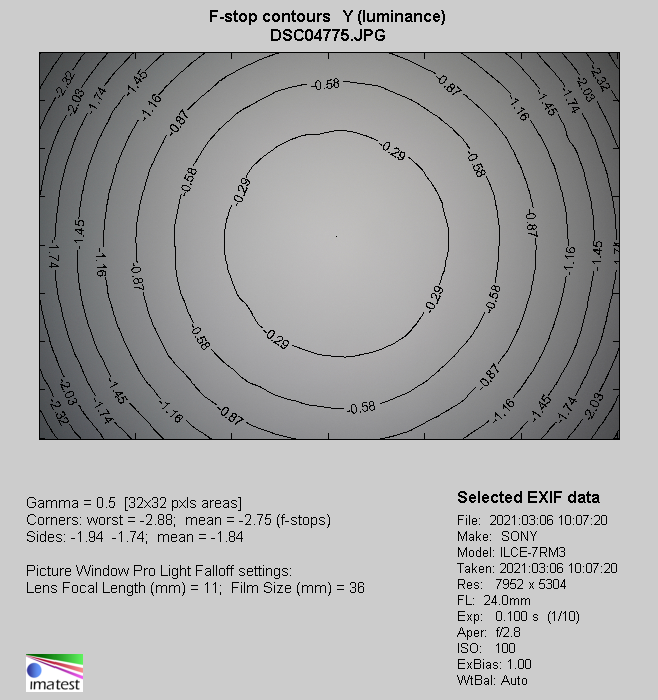Sony FE 24 mm f/2.8 G
8. Vignetting
First let's check vignetting on the smaller APS-C sensor – appropriate thumbnails you can find below.
| A7R III, APS-C, JPEG, f/2.8 | A7R III, APS-C, JPEG, f/4.0 |

|

|
Please Support UsIf you enjoy our reviews and articles, and you want us to continue our work please, support our website by donating through PayPal. The funds are going to be used for paying our editorial team, renting servers, and equipping our testing studio; only that way we will be able to continue providing you interesting content for free. |
- - - - - - - - - - - - - - - - - - - - - - - - - - - - - - - - - - - - - - - - - - - - - - - -
At the maximum relative aperture you have to take into account a loss of light of 30% (-1.03 EV) in the frame corners. On stopping down the aperture to f/4.0 that value decreases to 20% (-0.64 EV), and by f/5.6 it additionally drops to 14% (-0.44 EV). Further stopping down doesn't have any measureable effect on the aberration, described here.
After passing to full frame there are more problems and they are visible rather well in photos, presented below. You get JPEG files on the left and RAW files on the right.
| A7R III, FF, JPEG, f/2.8 | A7R III, FF, RAW, f/2.8 |

|

|
| A7R III, FF, JPEG, f/4.0 | A7R III, FF, RAW, f/4.0 |

|

|
| A7R III, FF, JPEG, f/5.6 | A7R III, FF, RAW, f/5.6 |

|

|
| A7R III, FF, JPEG, f/8.0 | A7R III, FF, RAW, f/8.0 |

|

|
First let's deal with JPEG files – in their case at the maximum relative aperture vignetting reaches a very high level of 61% (-2.75 EV). By f/4.0 that aberration decreases to 53% (-2.16 EV), and by f/5.6 it drops to 48% (-1.89 EV). By f/8.0 and f/11.0 you won't have any problems with noticing it either as it reaches, respectively, 43% (-1.61 EV), and 38% (-1.37 EV). Even by f/16.0 it still makes itself felt because our measurement amounted to 33% (-1.17 EV).
RAW files mean even more problems. By f/2.8 vignetting amounts to 65% (-3.02 EV) and on stopping down the aperture to f/4.0 it decreases to 57% (-2.44 EV). Results we got by f/5.6, f/8.0, f/11.0, and f/16.0 are, respectively: 54% (-2.27 EV), 53% (-2.17 EV), 51% (-2.04 EV), and 48% (-1.88 EV).
The results of the Sony 2.8/24G are quite similar to the performance of the Tamron 2.8/24. Both these lenses fared better than the small Samyang as its vignetting could approach even 74%.
| Sony A7R III, JPEG, f/2.8 |
 |






